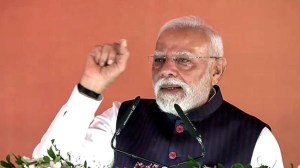AMID ESCALATING global trade tensions, the Commerce and Industry Ministry is assessing the risks of significant trade diversion from other countries to India and is particularly concerned about the likely surge in imports of US farm produce and factory goods from China, Vietnam and Indonesia into the country, a government official said on Tuesday.
“A recent assessment highlighted the risk of merchandise dumping into India due to reciprocal tariffs amid global trade tensions. Rising US costs may prompt exporters from countries like China, Vietnam, and Indonesia — all facing US trade deficits — to divert goods to India, potentially triggering import surges. Additionally, Chinese retaliatory tariffs on US goods could further increase the inflow of US agricultural products into India,” the official said.

Unlike other countries, China retaliated against US tariffs, which in turn has raised the risk of trade diversions globally. While the US has imposed a cumulative of 145 per cent tariffs on Chinese products apart from electronic items, Chinese tariffs on US items have also surged to a record 125 per cent. Notably, soybean and corn are the top US agri exports to China.
Story continues below this ad
To support stakeholders amid shifting global trade conditions, including tariff hikes, import surges, and export-related disruptions, the Directorate General of Foreign Trade (DGFT) under the Commerce Ministry launched the Global Tariff and Trade Helpdesk on April 11, 2025, the Commerce and Industry Ministry said.
The Indian Express had reported earlier this month that a high-level meeting had taken place at the Commerce and Industry Ministry to assess possible import surge as a result of trade diversions in the backdrop of the reciprocal tariffs.
“With a number of tariff announcements and subsequent pauses, things are in flux. But we are looking at import surges and have identified some countries for more intense monitoring. We have also picked commodities for closer watch because we are already aware of certain trends, and we are focusing on those commodities,” Commerce Secretary Sunil Barthwal said.
“Depending upon how the world is moving in terms of tariffs, counter-tariffs, exemptions and other developments, we are monitoring those imports. We are also in touch with our stakeholders. Our commodity divisions within the Ministry of Commerce are in contact with export promotion councils and various ministries. Based on the feedback, inputs, and data we analyse, remedial measures will, of course, be taken,” Barthwal said.
Story continues below this ad
Meanwhile, the Commerce Ministry said the Directorate General of Trade Remedies (DGTR), the anti-dumping watchdog, has issued final findings on 13 trade remedy investigations on imports in March alone, particularly from China and other countries such as Japan, Taiwan, and the European Union. Items include Vitamin-A Palmitate, Insoluble Sulphur, and Aluminium Foil up to 80 microns, among others.
Economists and trade experts have also raised concerns over a surge in exports from China. A research note by HDFC Bank on Friday stated that apart from the direct impact of US tariffs on Indian exports, India faces a “high risk” of oversupply from China, which could hurt domestic manufacturing.
“With the tariff increase on Chinese goods now effectively exceeding 60 per cent, it is more likely that a greater share of China’s supply could flow into other markets. This makes domestic manufacturing in countries like India vulnerable to cheaper Chinese oversupply,” noted Sakshi Gupta, Principal Economist at HDFC Bank.
According to Crisil Ratings, India faces a high risk of indirect impacts from US tariffs, particularly in electronics, machinery, and textiles, as Chinese exporters may divert their shipments to India as part of a geographical diversification strategy.
Story continues below this ad
“The top Chinese exports to the US, including electronics, machinery, and textiles, are particularly vulnerable to dumping, and their influx into the Indian market could impact domestic industries. However, the Indian government may impose anti-dumping duties to safeguard Indian exporters and mitigate any potential damage,” Crisil Ratings stated.
International think tank the Lowy Institute, in a recent research paper, estimated that about 80 per cent of countries traded more with China than with the US in 2023. However, the US remains a key driver of global demand, particularly as it has increased imports from countries such as Vietnam and Mexico, shifting away from China following the first round of Trump-era tariff hikes.
“This increase in imports from China is a combination of US tariffs prompting China to diversify into other markets and a redirection of its exports (parts and components) via other countries that ultimately serve the US market,” the think tank said.


































